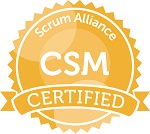 I recently taught a Certified ScrumMaster® (CSM) class at Watermark Learning. Our two-day class is packed full of real-world examples of how to apply Scrum to solve complex problems. Of course, there is never enough class time to work through the backlog of questions that students raise, and as a passionate Scrum practitioner, this nags at me. Then I realized, while the class may be time-boxed, my opportunity to blog is not; plus, blogging allows me to share, not only with my class, but with the broader Scrum community, as well.
I recently taught a Certified ScrumMaster® (CSM) class at Watermark Learning. Our two-day class is packed full of real-world examples of how to apply Scrum to solve complex problems. Of course, there is never enough class time to work through the backlog of questions that students raise, and as a passionate Scrum practitioner, this nags at me. Then I realized, while the class may be time-boxed, my opportunity to blog is not; plus, blogging allows me to share, not only with my class, but with the broader Scrum community, as well.
With that, let’s explore two of the questions raised in a recent CSM® course.
How Important is Knowing How to Use Agile Tools – Like Rally?
Tools are great – no really, they automate manual tasks, provide sophisticated dashboards, and ensure that organizations have a common repository and mechanism for all of their Scrum teams.
However, there are a few words of caution that I want to offer regarding tools. First, a tool will not make you “Agile” any more than buying the most sophisticated scale will make you lose weight. My business partner, Jim Ruprecht, has a long-held mantra, which everyone who ever worked for him learned in their first 10-minutes: “Purpose before process, and process before technology.” Shifting to an Agile method, like Scrum, is a shift in mindset that is better addressed by understanding your purpose (the “why” behind your desire to move to an Agile-way of working), modifying your product development process to reflect your chosen method, Scrum, and then looking at how you can use technology to support the change in behavior required to achieve your “why.”
Second, remember that one of the foundations of Scrum is empiricism – gaining knowledge by actually developing the product. One of the critical success factors in managing an empirical process is “transparency.” Tools have the ability to help provide transparency, but only if they are easily accessible. So, instead of hiding your tool behind unique pathways and secure passwords, allow at least some of those dashboards to be broadcast throughout the organization. One way of accomplishing this task is simply to put the dashboards on a loop and broadcast them on monitors throughout your team area.
Tools are great, but they will only enhance your agility. They will not make you “Agile.”
Learn More about our Agile Training, Coaching, and Certification Preparation
What Should I Watch Out for When Considering Agile Vendors?
When evaluating vendors to work with you on a Scrum-based effort, it is important to first determine what the vendor means when they say, “Scrum,” because different vendors can mean different things. In fact, it is not unusual for vendors to co-opt Scrum concepts and ideas, slap them on a waterfall method, and call it “Scrum.” A joint-training session between the vendor and the customer can help establish a common foundation and avoid costly misunderstandings.
With a solid understanding of Scrum in place, the next key question is, “Are we jointly developing this product or is the vendor developing it for the customer?”
In the former case, building true cross-functional development teams comprised of both vendor and customer personnel is key. As these teams develop the product and evolve together, an emphasis should be placed on ensuring that knowledge-transfer is occurring, so when the vendor departs, the customer is left with sufficient understanding and skill to maintain and extend the product moving forward.
In the latter case, where the vendor is developing the product on behalf of the customer, the customer needs to appoint a strong Product Owner to be successful. This Product Owner needs to embody the attributes of any great Product Owner, including being authoritative about product decisions, available to the Development Teamm and knowledgeable about the domain that will be served by the product.
In short, working with vendors using Scrum means following the framework as designed and exhibiting good discipline in its execution.
In subsequent posts, I will address additional questions raised in my CSM courses. In the meantime, please leave a comment below, and check out our next Certified ScrumMaster® course at Watermark Learning. It would be great to discuss these topics and others with you in our next session.
Innovative, servant leader with extensive IT experience and a passion for process improvement. Demonstrated leadership improving team performance in the midst of significant organizational change. Positive, team-oriented management style achieving results through systematic analysis, collaboration and strong project management.


 New Horizons
New Horizons
 Project Management Academy
Project Management Academy
 Six Sigma Online
Six Sigma Online
 Velopi
Velopi
 Watermark Learning
Watermark Learning
 Login
Login




 New Horizons
New Horizons
 Project Management Academy
Project Management Academy
 Velopi
Velopi
 Six Sigma Online
Six Sigma Online
 Watermark Learning
Watermark Learning